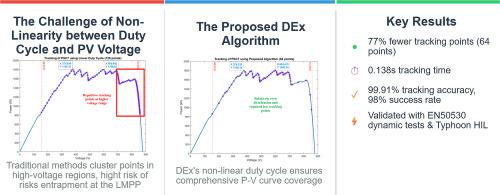PV串复部分遮阳条件下的确定性双指数最大功率点跟踪算法
IF 4.9
3区 计算机科学
Q1 COMPUTER SCIENCE, HARDWARE & ARCHITECTURE
引用次数: 0
摘要
在光伏(PV)系统中,固有的占空比与PV电压之间的非线性关系对有效的最大功率点跟踪(MPPT)提出了重大挑战,现有文献尚未对其进行充分研究,导致跟踪算法次优。本文引入了双指数(DEx) MPPT算法来缓解这种非线性。提出的DEx MPPT算法减少了77%的跟踪点,降低了GMPP跟踪时间,同时保持了整个跟踪区域的全面覆盖。对于开路电压为906.2 V的20个光伏面板,DEx在部分遮阳条件下沿复杂的P-V曲线有策略地分配跟踪点。大量的仿真表明,DEx优于确定性和元启发式MPPT方法,跟踪时间为0.138 s,跟踪准确率为99.91%,成功率为98%。此外,DEx在EN50530动态测试中规定的波动辐照度下表现出有效性。利用Typhoon HIL 404半实物系统和TI-F28379D实时微控制器进一步验证了实时跟踪性能。本文章由计算机程序翻译,如有差异,请以英文原文为准。

A deterministic double-exponential maximum power point tracking algorithm for PV string complex partial shading condition
In photovoltaic (PV) systems, the inherent non-linear relationship between duty cycle and PV voltage poses a major challenge for effective Maximum Power Point Tracking (MPPT) remains underexplored in existing literature, leading to suboptimal tracking algorithms. This paper introduces the Double-Exponential (DEx) MPPT algorithm to mitigate this non-linearity. The proposed DEx MPPT algorithm reduces tracking points by 77 %, lowering GMPP tracking time while maintaining comprehensive coverage of the entire tracking region. For a 20-panels PV string with 906.2 V open circuit voltage, the DEx strategically allocates tracking points along complex P-V curves under partial shading conditions (PSCs). Extensive simulations show DEx outperforms deterministic and metaheuristic MPPT methods, achieving 0.138 s tracking time, 99.91 % tracking accuracy, and 98 % success rate. Moreover, DEx demonstrates effectiveness under fluctuating irradiance specified in the EN50530 dynamic test. Real-time tracking performance is further validated using a Typhoon HIL 404 hardware-in-the-loop system and TI-F28379D real-time microcontroller.
求助全文
通过发布文献求助,成功后即可免费获取论文全文。
去求助
来源期刊

Computers & Electrical Engineering
工程技术-工程:电子与电气
CiteScore
9.20
自引率
7.00%
发文量
661
审稿时长
47 days
期刊介绍:
The impact of computers has nowhere been more revolutionary than in electrical engineering. The design, analysis, and operation of electrical and electronic systems are now dominated by computers, a transformation that has been motivated by the natural ease of interface between computers and electrical systems, and the promise of spectacular improvements in speed and efficiency.
Published since 1973, Computers & Electrical Engineering provides rapid publication of topical research into the integration of computer technology and computational techniques with electrical and electronic systems. The journal publishes papers featuring novel implementations of computers and computational techniques in areas like signal and image processing, high-performance computing, parallel processing, and communications. Special attention will be paid to papers describing innovative architectures, algorithms, and software tools.
 求助内容:
求助内容: 应助结果提醒方式:
应助结果提醒方式:


